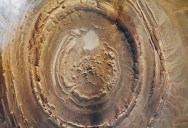Why The “Eye Of The Sahara” Is A Geological Mystery

I kind of like the idea that, as much as we know about our planet and the universe around us, there are still mysteries that science really hasn’t been able to explain – at least not yet.
And the “Eye of the Sahara” definitely falls into that category.
We can only really see the Eye of the Sahara from far above, and at first glance, it looks just like a huge impact crater in the middle of the Sahara Desert.
It’s about 30 miles in diameter and contains a series of uniform ripples.

That’s exactly what the geologists who initially studied the Eye thought it was – an enormous impact crater – but more research into the sedimentary rock in the central dome has dated it to the late Proterozoic period.
That’s between 1 billion and 542 million years ago.
They say the structure likely formed through a process called “folding,” which created the symmetrical anticline. Folding takes place when tectonic forces on either side squeeze the sedimentary rock. If that rock is cold and brittle it can fracture, but if the rock is warm, it folds.
Folds that form upwards, like the ones in the Eye, are called an anticline. If they go the other way, they’re a syncline.
In 2014, though, a group of researchers published a different formation theory for the Eye.
They suggest the presence of volcanic rock suggests evidence of molten rock being pushed to the surface and creating the dome shape. Then, it eroded into the rings.
The paper proposes that the separate of Pangaea might have played a part in its formation.
The Eye is made up of a mixture of sedimentary and igneous rock, and erosion across the surface shows fine-grained rhyolite and coarse crystalline gabbro rocks that have been altered by hydrothermal alteration.

The types of rock across the rings erode at different speeds, giving it different colored patterns over the surface.
The swirling, colorful irregularities are made by large, sharp-angled fragments called megabreccia.
The dome in the center contains a limestone-dolomite shelf made of breccia, ring dikes, and alkaline volcanic rock.
The Eye’s structure has been a mystery for as long as it’s been a known phenomenon, and remains one of the most impressive geological features in the world.
If you think that’s impressive, check out this story about a “goldmine” of lithium that was found in the U.S. that could completely change the EV battery game.

Sign up to get our BEST stories of the week straight to your inbox.




